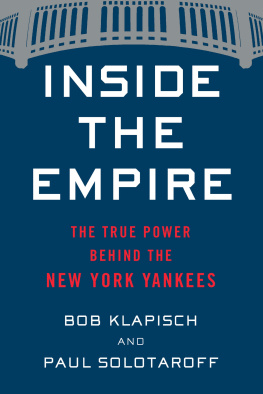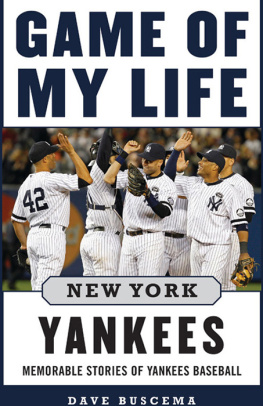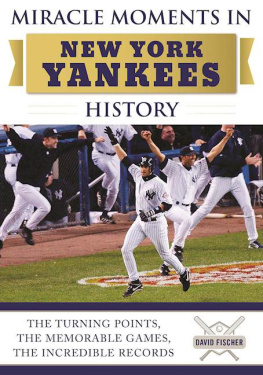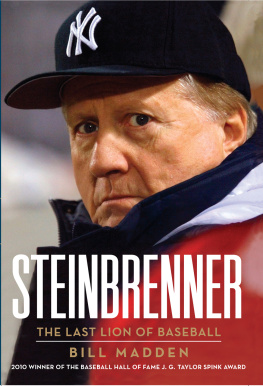Copyright 2019 by Bob Klapisch and Paul Solotaroff
Photographs copyright 2018 by Anthony J. Causi
All rights reserved
For information about permission to reproduce selections from this book, write to or to Permissions, Houghton Mifflin Harcourt Publishing Company, 3 Park Avenue, 19th Floor, New York, New York 10016.
hmhbooks.com
Library of Congress Cataloging-in-Publication Data
Names: Klapisch, Bob, author. | Solotaroff, Paul, author.
Title: Inside the empire : the true power behind the New York Yankees / Bob Klapisch and Paul Solotaroff.
Description: Boston : Houghton Mifflin Harcourt, 2019. | Includes bibliographical references and index.
Identifiers: LCCN 2018057177 (print) | LCCN 2018060027 (ebook) | ISBN 9781328589125 (ebook) | ISBN 9781328589354 (hardcover)
Subjects: LCSH: New York Yankees (Baseball team)ManagementHistory.
Classification: LCC GV875.N4 (ebook) | LCC GV875.N4 K53 2019 (print) | DDC 796.357/64097471dc23
LC record available at https://lccn.loc.gov/2018057177
Cover design by Brian Moore
Cover image Michael Heiman / Getty Images
eISBN 978-1-328-58912-5
v1.0319
To the crew at Casa Klapisch: Kristy, Casey, Kaley, and Corky
Bob Klapisch
For CC and Luke, who light the path and keep me firmly to it
Paul Solotaroff
1
Locked and Loaded:
Welcome to the Bronx Power Station
The General Manager Meetings each fall are baseballs version of a buddies fishing junket to Belize. Executives harrowed by the grind of the seasonsix months of seven-day/eighty-hour weeks; back-page eruptions after three-game slumps; and side-eyed shade from their high school daughters over another pre-prom party not attendeddisappear for four days in mid-November to a luxe hotel overlooking a golf course.
None of the GMs can putt worth a damn, but the greens are beside the point. Their fixed destination is the lobby bar, where someones playing piano, the shades are drawn against the late-fall sun, and thirty men with the hardest jobs in the trade can let loose and get buzzed. Each man has his clique of whiskey palsthe ones he met while working his way up the organizational chart of his club, or the two or three peers hes grown comfortable making deals with since he ascended the throne. Not a lot gets done at these boys-club excursions, in part because of the calendar. The free-agent market is barely a week old, no ones finalized his forty-man roster, and the needs of each team wont fully manifest until the frenzy of Winter Meetings one month hence. Those events, held in mid-December at another Kubla Khan luxe resort, are a Ford Bronco chase of trades and desperation, capitalism on a four-day crack toot.
In addition, supplicants by the thousands show up to try to make their luck there: vendors, beat writers, unemployed scouts and coaches, and moon-eyed fans and their kids. Such is the noise and traffic that GMs hole up in their suites, texting each other madly to find a right-handed bat or a couple of young pitchers with controllable years. The stakes couldnt be higher for those concerned. Any executive who goes home empty this year may be back at next years Winter Meetings looking for work.
Still, its not like nothing happens at the GM meetings one month prior. Over third and fourth cocktails, GMs pull each others strings for leads on what they hope theyll get done later. At one point or another, most will pay homage to the guy or two holding all the cards: the lucky executives who happen to have deep wells of talent on their Double- and Triple-A rosters. In this, the Age of the Real-Deal Drug Test and the Cant-Miss Hall of Famer Clogging the Lineup, nobody wants the fading superstar with the enormous contract. What the GMs wantoverwhelminglyis to get younger and cheaper: to trade a couple of peak seasons from their franchise left fielder for a pair of live-armed kids who are on the brink.
It was precisely in that spirit of here-goes-nothing that Mike Hill, the director of baseball operations for the fire-sale Miami Marlins, tapped Brian Cashman on the shoulder in November 2017 in the hallway of the Waldorf Astoria in Orlando. After fifteen years of being a reluctant shopperthe one guy who showed up every winter with strict orders to overpay for back-nine playersCashman, the general manager of the New York Yankees, was suddenly in the catbird seat. Through a series of canny drafts and quick-strike deals at the trading deadline a year or so back, hed miraculously recast himself as a master builder, the cool kid with all the hot toys. He had seven of the hundred best prospects in the game (plus a wave of kids behind them who were almost as good) and a major league roster of newly minted mashers whod bulled their way to within a game of the World Series.
Cashman also had the one great luxury in the room: permission to do absolutely nothing. His Baby Bombers had come of age two years early and bought him a full season to sit tight. With a mix of pending superstars on minimum-salary deals (Aaron Judge, Gary Snchez, Luis Severino), cut-rate acquisitions on the cusp of stardom (Didi Gregorius, Chad Green, Sonny Gray), and just the right garnish of graybeard leaders to run the locker room (Brett Gardner, CC Sabathia, David Robertson), he could bide his time for the auction to end all auctions: the 2019 free-agent class. Come November of the following year, hed have a hundred million or more in luxury cap space to add the keystone blocks for a five-year run: perhaps Bryce Harper to bang dents in the second-deck facade, Manny Machado to anchor a world-class infield, or Clayton Kershaw to start Game 1 of the World Series.
Still, you know: it never hurts to talk. We were walking down the hall when either Hill or I broached the subject of Stanton, Cashman says. Giancarlo Stanton was the circus-strongman slugger whod pummeled the National League for eight years. Fresh off a fifty-nine-home-run season and a Most Valuable Player Award in 2017, he was a wild extravagance on the now-threadbare Marlins, a Ferrari at a drive-in showing The Florida Project. The Marlins franchise (and its many hundreds of millions in debt) had been sold months before, for $1.2 billion, to a baggy-suited rich guy by the name of Bruce Sherman and his new partner, Derek Jeter. Of the several entities that pursued the Marlins (among them, a consortium headed by Jeb Bush and another by Jared Kushners father, Charles), the Sherman-Jeter group seemed the least provisioned to ride out years of heavy losses. Sherman had walked away from Private Capital Management, his wealth management firm, after a string of big bets blew up in his face. Among them were sunk positions in Bear Stearns, the Great Crash failure, and newspaper chains like Knight Ridder and Gannett that chunked off billions of dollars in high-speed losses. Over four years time, PCMs portfolio shrank by 90 percent. To be sure, Sherman owned a $70 million yacht, which he had humbly christened The Majestic, and hed deftly repotted himself in old-growth Naples, where he chaired a wine festival every winter. But in team-owner waters, he was plankton to sharks, a multimillionaire in a billionaire boys club.
The Sherman-Jeter purchase of the Marlins was predicated on a promise that theyd made to the other owners in the game: that theyd instantly strip the team of homegrown stars and slash its obligations to the bone. Having overshot the market by about $200 milliontheir chief rival, a construction magnate named Jorge Mas, had stopped bidding at $1 billionthey told their fellow owners that theyd go the Houston Astros route: tank for four years while turning a modest profit and building back a core of young talent.







